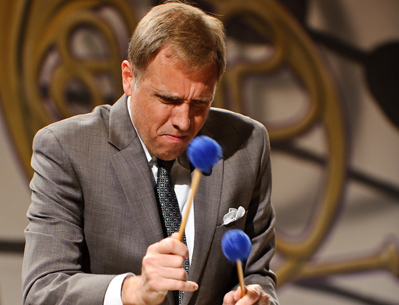Dec 9, 2025 12:28 PM
In Memoriam: Gordon Goodwin, 1954–2025
Gordon Goodwin, an award-winning saxophonist, pianist, bandleader, composer and arranger, died Dec. 8 in Los Angeles.…

Ann Arbor Blues Festival 1969–Vols. 1 & 2 offers performances by a parade of blues VIPs.
(Photo: Courtesy Third Man Records)Michael Robert Frank, founder and CEO of the label Earwig Music, has completed his greatest rescue mission. “I’ve believed that the Bea & Baby record label had too much great country and urban blues, doo-wop and gospel to let it go into the dustbin of history,” he said. “So, I’ve produced a deluxe, complete testament to all the musicians and to Cadillac Baby. I took the project on as a fan, to create something to be dug into deeply, a source of enchanting discovery to be cherished.”
The box set Cadillac Baby’s Bea & Baby Records: The Definitive Collection (Earwig Music) brings to light the long-neglected recording legacy of Narvel “Cadillac Baby” Eatmon (1914–’91). Based on Chicago’s South Side, Eatmon was a club and label owner who scouted out artists, especially blues musicians, for gigs and sessions. In addition to 101 tracks spread across four CDs, the set has a 128-page book with rare photos and essays by blues authorities Jim O’Neal and Bill Dahl, as well as gospel historian Robert M. Marovich.
The set (spanning 1959–’89) showcases more than 30 recording artists. Blues fans, in particular, have lots to explore. Wild slide guitarist Hound Dog Taylor’s first recordings are here, and a young James Cotton gruffly sings “One More Mile,” using resolve to mute a penetrating sadness. Among the others plunging into the blues with personality are Eddie Boyd, Earl Hooker, Homesick James, Sunnyland Slim, Detroit Junior and Lee Jackson. R&B acts no longer lost in the mists of time include Kirk Taylor & The Velvets and Faith Taylor, who cut two tracks at age 11. African American gospel singers turn up on Disc 4, notably the transcendently impassioned Eddie Dean. On six tracks, Cadillac Baby himself is heard discussing his fascinating life and career.
Stories about the man are legion. Perhaps none more outlandish than the account of him driving one of the convertible Cadillacs he owned through his club’s entrance door, up a ramp and onto the stage. He then cruised over to the bar.
In 2006, Earwig Music bought Bea & Baby and its associated labels from Cadillac’s widow, Bertha (aka Bea). The transaction got Frank thinking about a compilation. With stacks of 45s and a bushel of paperwork in his possession, he began doing research. He spent years organizing a discography and tracking down missing records owned by collectors. He then created new digital masters.
In addition to issuing 76 albums on Earwig, Frank has ranged freely throughout the blues world as an artist manager, booking agent, and producer of albums and the occasional event. He’s also a harmonica player, long serving as an accompanist to bluesman David “Honeyboy” Edwards (1915–2011), whom he managed.
All the while, Frank has been motivated by altruistic instincts. “As I learned more about the histories and obstacles faced and overcome by musicians, especially blues musicians, I began to appreciate their lifetime commitment to creating and performing. [These artists are] revolutionary and inspiring. I wanted to help them to have better economic opportunities by playing to larger, more diverse audiences and to make more recordings.
“On an experiential level,” he continued, “I felt the transformational power, emotion and cultural magnificence of the music. I wanted to share all that—so the public could experience the music and the artists as deeply as I did.”
Another labor of love by a committed blues fan was Jim Fishel’s restoration and compiling of tapes he made a half century ago as a teenager at a three-day event near the campus of the University of Michigan. Now issued as Ann Arbor Blues Festival 1969–Vols. 1 & 2 (Third Man Records), the set offers one or two performances each by a parade of blues VIPs, including B.B. King, Howlin’ Wolf, T-Bone Walker, Muddy Waters, Junior Wells, Son House, Mississippi Fred McDowell, Lightnin’ Hopkins, Roosevelt Sykes, Big Mama Thornton, Big Joe Williams and Clifton Chenier.
Up-and-comers of the time were out in force, too. Guitar firebrands Magic Sam, Otis Rush and Jimmy “Fast Fingers” Dawkins agitated a barbed-wire tension that surely affected thousands of concertgoers. Harmonica players James Cotton (“Off The Wall”), Junior Wells (“Help Me–A Tribute to Sonny Boy Williamson”) and Charlie Musselwhite (“Movin’ And Groovin’”) dazzled the college crowd as well. A 26-page booklet provides details on the event, one of the first U.S. festivals devoted solely to the blues. A deluxe edition includes reproductions of tickets, news articles, production notes and more.
Like the Bea & Baby box set, overall the sound quality here is acceptable, with historical importance trumping sonic purity. DB

Goodwin was one of the most acclaimed, successful and influential jazz musicians of his generation.
Dec 9, 2025 12:28 PM
Gordon Goodwin, an award-winning saxophonist, pianist, bandleader, composer and arranger, died Dec. 8 in Los Angeles.…

Belá Fleck during an interview with Fredrika Whitfield on CNN.
Jan 13, 2026 2:09 PM
The fallout from the renaming of the John F. Kennedy Center for the Performing Arts to include President Donald…

Flea has returned to his first instrument — the trumpet — and assembled a dream band of jazz musicians to record a new album.
Dec 2, 2025 2:01 AM
After a nearly five-decade career as one of his generation’s defining rock bassists, Flea has returned to his first…

Dec 11, 2025 11:00 AM
DownBeat presents a complete list of the 4-, 4½- and 5-star albums from 2025 in one convenient package. It’s a great…

Vibraphonist Chuck Redd found himself in the midst of a political firestorm after canceling his gig Dec. 24 at the newly renamed Trump Kennedy Center.
Jan 6, 2026 2:32 AM
The Board of Trustees at Washington, D.C.’s Kennedy Center for the Performing Arts voted on Dec. 18 to rename the…